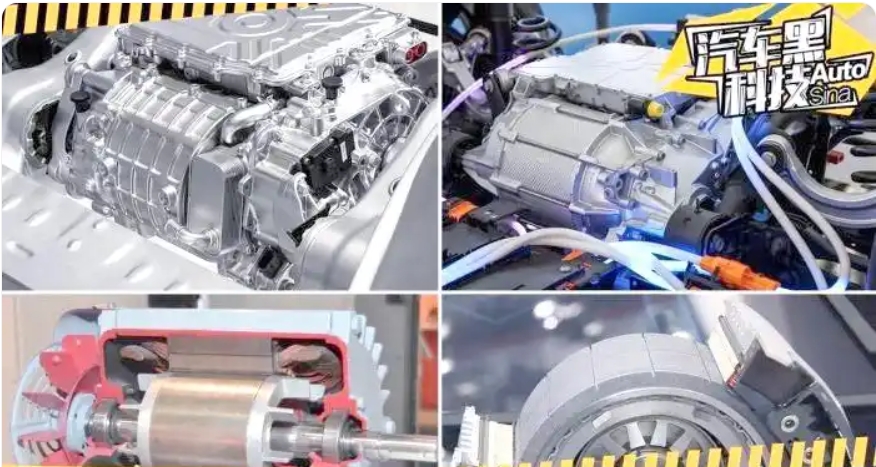The role of motors in electric vehicles
When discussing why electric vehicles choose different motor types, we first need to understand the core position of motors in electric vehicles. As the driving system of electric vehicles, the type and performance of motors directly determine the driving characteristics of the vehicle. Therefore, choosing the right motor type is crucial to the performance of electric vehicles.
Energy conversion comparison
From the perspective of energy conservation, the engine of a traditional fuel vehicle converts chemical energy into mechanical energy. Even if its thermal efficiency can reach 50%, the overall energy conversion rate is still relatively low. This is mainly because the energy output by the engine needs to pass through the gearbox, drive shaft and other links before it can be transmitted to the wheels, and some energy is lost in the exhaust and cooling systems. In contrast, electric vehicles directly generate current to drive the motor through electron transfer , and the energy utilization rate can be as high as 80%-90%. Taking an electric vehicle with an electricity consumption of 16kWh per 100 kilometers as an example, it only consumes 5.76X10^7 joules of energy for every 100 kilometers. Under the same mileage, a fuel vehicle with a fuel consumption of 8L per 100 kilometers consumes 2.686X10^8 joules of energy, which is nearly 5 times that of an electric vehicle.
AC asynchronous motor
How it works
Among the types of electric motors used in electric vehicles, AC asynchronous motors occupy a place. This type of motor uses the interaction between the magnetic field generated by the stator and the induced current in the rotor to generate torque to drive the vehicle. The AC asynchronous motor uses the interaction between the stator magnetic field and the rotor induced current to generate torque without the need for external current . Its structure includes a fixed stator and an internal rotor. The stator is made of layers of silicon steel sheets and is wound with coils (i.e. windings). When current passes through, a magnetic field is generated.
Advantages and Disadvantages Analysis
Its advantages are simple structure, reliable operation and relatively low maintenance cost . However, due to the presence of mechanical contact parts such as slip rings and brushes, long-term use may cause wear, which in turn affects its performance and life. In addition, the torque characteristics of AC asynchronous motors at low speeds are relatively weak, which also limits its performance in certain application scenarios. Despite this, AC asynchronous motors are still widely used in the field of electric vehicles. Through continuous technical improvements and optimizations, its performance and efficiency have been significantly improved, thus meeting the needs of more consumers.
Permanent magnet synchronous motor
How it works
Permanent magnet synchronous motors are distinguished from three-phase AC asynchronous motors by their unique permanent magnet design. Their structure also includes a stator and a rotor, but permanent magnets are embedded in the rotor, which can generate a magnetic field without external current. Permanent magnet synchronous motors generate magnetic fields with the help of permanent magnets, do not require external current, and are highly efficient . This makes permanent magnet synchronous motors perform more efficiently and reduce energy waste.
Advantages and Disadvantages Analysis
However, the use of permanent magnets also brings certain cost pressures, and their performance is affected by the external environment, such as temperature and humidity, which limits their application scope to a certain extent. Permanent magnet synchronous motors are widely used in electric vehicles, especially in the gearboxes of long-range electric vehicles and some hybrid vehicles. Due to their high efficiency, permanent magnet materials are prone to overheating and demagnetization, requiring a good cooling system design. Many automakers pay special attention to the optimization of motor and battery cooling systems to ensure their stability and performance under high temperature or high speed conditions.
Summary and Outlook
After the previous discussion, we have a deep understanding of the working principle of permanent magnet synchronous motor and its application in the automotive field. This motor plays a vital role in the transmission of long-range electric vehicles and some hybrid vehicles with its high efficiency, small size and high power . However, we have to admit the challenges it faces, such as the problem that permanent magnet materials may demagnetize due to overheating. Today, as automakers continue to pursue better performance, powerful motor and battery cooling systems are particularly important. They ensure the realization of excellent performance such as 10 launch starts without attenuation and high-speed cruising without attenuation.
In the drive system of pure electric vehicles, both AC asynchronous motors and permanent magnet synchronous motors are widely used. Permanent magnet synchronous motors are often used in long-range electric vehicles, while AC asynchronous motors are more common in traditional vehicles . Manufacturers are working hard to improve the performance of various types of motors to meet different market demands.
Post time: May-28-2025
